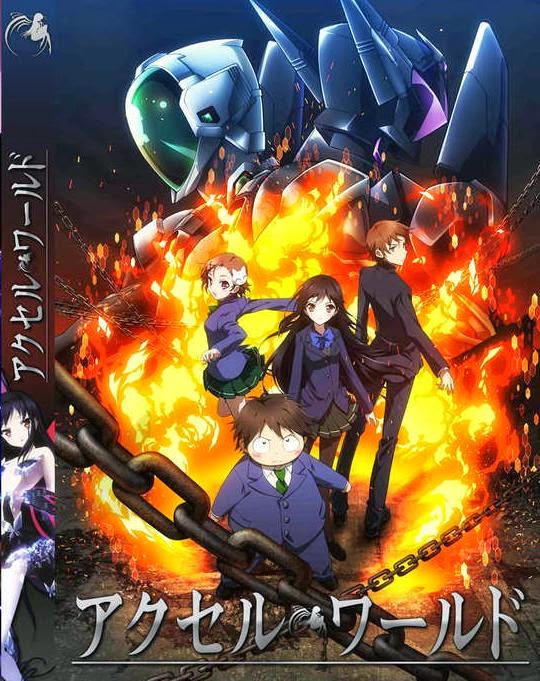The technologically advanced world of 2046 is the setting for this 24-episode series. Most people at this time use Neuro-Linkers to access the Internet, interact online and explore virtual and augmented worlds. This neuro-linker is worn like a collar and can interact with the brain.
Hardcore gamer Arita Haruyuki uses this technology constantly to get away from his miserable life at Umesato Junior High School despite having good friends like Mayuzumi Takumu and Kurashima Chiyuri. Fat, short and timid, Haru is a target for bullies. In one of his bad days, he plays squash where he has always dominated the scoreboards. Unfortunately, even in that game someone finally bested him. The intruder Kuroyukihime was impressed by Haru's abilities and wants to be friends with him. His complete opposite, Kuroyukihime is good-looking and famous which only made Haru more suspicious of her intentions.
 |
| Kuroyukihime and Haru |
 |
| Kuroyukihime and Haru in their avatars |
The next day after their first meeting, Kuroyukihime asks Haru to cable with her and to try installing a program called Brain Burst. Haru soon learns that the program enables the user to temporarily freeze time by accelerating the brainwaves. Moreover, Brain Burst is also a fighting game where Burst Linkers duel for Burst Points so they can keep using acceleration. Losing all the burst points however automatically uninstalls the program, an event most of the burst linkers fear.
Haru's avatar, called Silver Crow, reflects his subconsciousness. His desires, fears and frustrations show in his virtual features and abilities. Being a gamer, it was easy for Haru to understand the mechanics of the game. Soon enough, his popularity grew and he became good friends with Kuroyukihime. Their goal now is to reach level 10, defeat the Six Kings of Color, and discover the meaning and purpose of Brain Burst. The six kings are the only extant players who have reached level 9. They were in a stalemate when they decided to set a truce preventing each other from attacking the rest to gain burst points. This peace was broken by Black Lotus who is now hunted by other burst linkers.
 |
| Haru's friends Takumu and Chiyuri |
In this background, Haru's mettle will be tested. Not only has he to deal with foes but with friends and himself. Burst Link may be just a game but for hardcore burst linkers like them, fighting for survival and domination is like a fight for life.
 |
| Silver Crow |
The lead character Haru is an unusual protagonist because of his appearance. Moreover he is cowardly, shy and constant victim of bullies. As expected the lead female Kuroyukihime has the opposite qualities. A typical but effective pair for a series about a game and the gamers. I saw several brilliant moments in the 24 episodes whenever Haru spoke from the point of view of a gamer. Games as an escape for reality is true for most people with Haru's background and personality. Although I am not a fan of escapism, gaming is a good venue to redeem oneself, make friends and strengthen real-world friendships. As a gamer, I appreciate all the details they put into the action scenes, the tension caused by the struggles to dominate, and the mentality of the burst linkers. The serious dedication of the players is almost reminiscent of the nearly-foolish but awesome people who label themselves hardcore (some even die playing). After all, the joy in playing games is in losing oneself in all the action and fun.
Action scenes abound. I like how the setting is taken into account in every fight. There are also a lot of details put into the history, appearance and function of the armor, weapons and other abilities of the players --- making it a more convincing series about a game than Sword Art Online. The good animation also justified what the series wanted to deliver.
The romance part was only hinted at but not pursued. Fanservice is also present; a feature that could have been omitted if you ask me.
The ending leaves enough room for a sequel if there's any, but is also good enough for a cliffhanger conclusion to the mystery of the Brain Burst if one observes the growth of the lead character.
There are also some things hinted at in the series. One of those I've noticed is the use of the neuro-linker. It is a collar which seems to imply that a technologically advanced society makes slaves out of the people. If games and virtual reality were a reflection of people's happiness and pain, then I do not think an advanced society is any different from the primitive. After all, only our methods of interacting, loving or harming others will change but not ourselves.
Rating: 8.5 out of 10















































